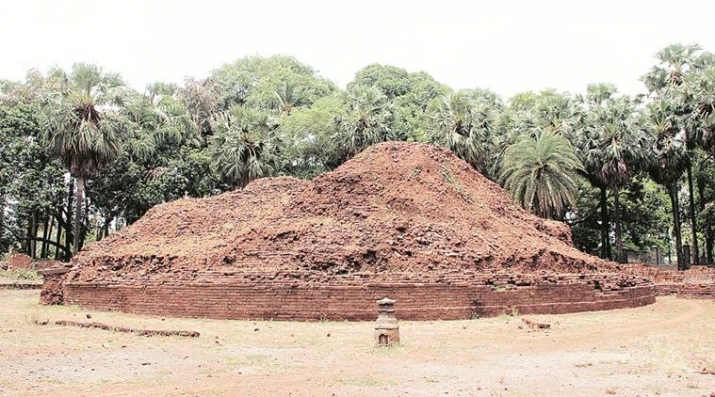NEWS
Designated Hub of Maharashtra Buddhist Circuit Still Neglected
 Nalasopara Stupa. From indianexpress.com
Nalasopara Stupa. From indianexpress.comDespite a decision in 2014 to make the 2,500-year-old Nalasopara Stupa in Maharashtra, India, the hub of the state’s Buddhist circuit, the site still lies largely neglected, according to a recent report in The Indian Express. “Every evening, few locals come and sit on the benches bordering the stupa to enjoy a whiff of the evening air,” said a local living in a hut nearby. “In the past few years, the number of pilgrims have steadily been increasing but infrastructure remains the same.” (The Indian Express) According to the report, there is not even a sign leading to the site.
Plans to restore and preserve the stupa and to turn it into a “tourist hotspot” were announced by Maharashtra’s chief secretary Ratnakar Gaikwad as early as 2011. (The Times of India) The stupa was already under the jurisdiction of the Archaeological Survey of India, but was in a virtual state of abandonment. As part of the plan to make the site an international center, a nine-foot statue of the Buddha donated by a Buddhist charitable trust based in Pune was installed 200 meters (656 feet) from the stupa and unveiled by state dignitaries. Buddhist monks from across the nation were invited to attend the event.
In addition, an entrance gate to the stupa costing Rs 13 lakh (over US$20,000) was inaugurated and 35 acres of government land in Karmale Village were designated for the center. “The plan includes meditation centres, a museum and a mini theatre where a film on the stupa will be shown to tourists. Slide shows and guides will also be made available at the site. Hotels and dharamshalas will be constructed near the stupa to attract both foreign and Indian tourists. Plans are underway to organise an international Buddhist conference at the stupa site in October,” reads the May 2011 The Times of India report.
The stupa has great historical significance, having been built under the reign of the great Mauryan emperor Ashoka (304–232 BCE), who is said to have constructed 84,000 stupas to house the Buddha’s relics.
Nalasopara, formerly known as Sunaparanta, was in ancient times a major port town with trade links to Mesopotamia, Arabia, Greece, Rome, and Africa. As the story goes, a rich merchant from the town named Purna Maitrayaniputra, after attending a teaching by the Buddha in Shravasti in Uttar Pradesh, took ordination and built a vihara (monastery) in the town, which was inaugurated by the Buddha himself along with 500 of his disciples. To keep the memory of the Buddha alive, Purna asked him for his begging bowl, which is said to have been discovered at the site. (The Financial Express
The 8th and 9th of Ashoka’s 14 edicts were reportedly also found close to the site, according to a “dilapidated” board outside the stupa, which also states that King Ashoka’s son Dharmendra and daughter Sanghamitra passed through the area when traveling to Sri Lanka from Bodh Gaya carrying branches of the Bodhi tree. (The Indian Express)
The site was first excavated in April 1882 by Pandit Bhagwandas Indraji, who discovered the stupa as well as a stone coffer, caskets, gold figures, seals, and seven images of the Buddha and one of Maitreya, which are now kept in The Asiatic Society of Mumbai. From 1939–40, the site was re-excavated by M. M. Qureshi of the Archaeological Survey of India, who discovered several stone lintels and two small stupas on the south side of the main stupa.
Like the Sanchi stupa in Madhya Pradesh, the main stupa was adorned with sandalwood carvings. The main entrance features an altar, with a Buddha image placed in a stone compartment. The mound measures some 65 yards around the base and rises about 17 feet with steps from the eastern side.
See more
Maharashtra: Nallasopara Buddhist stupa proves it was once hotbed of Buddhism The Indian Express)
Nalasopara to be centre of Buddhist circuit in Maharashtra (The Financial Express)
9-foot Buddha statue to be installed at Nalasopara stupa (The Times of India)
Buddhist Stupa at Nalasopara (The Buddhist Forum)
Nala Sopara (Wikipedia)














